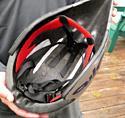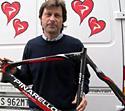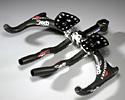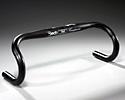
Recently on Cyclingnews.com |
Tech News – April 27, 2005Edited by John Stevenson Got tech? Send press releases, news, and tech questions to the Cyclingnews tech desk. Lance's new AdvantageGiro TT helmet goes to next levelBy Tim Maloney Last year at the Dauphiné Libéré, we saw Giro's prototype in-mold TT helmet that was compatible with the UCI's new safety standard. At this year's Tour de Georgia, Giro's senior marketing manager Toshi Corbett showed us the production version of this speedy lid that is part of the Santa Cruz, CA firm's contribution to the ongoing F-One project designed to give Lance Armstrong and his Discovery Channel teammates a competitive advantage when it comes to equipment. Giro has taken the F-One program literally in creating a name for the aero topper, calling the sleek silver head bullet the 'Advantage.' Corbett told Cyclingnews, "over two years ago when Lance asked us to give him the best and fastest material available, the F-One Project was born. At Giro, we set a benchmark to save 13 seconds in a 56km TT in the Tour de France. Last year, the version you saw at the Dauphiné and the Tour was a 'tape on' version, not an in-mold version." That's helmet-speak for a helmet where the polycarbonate plastic shell is taped to the expanded polystyrene (EPS) liner. "This prototype was UCI approved just before the Dauphiné last year, but then our plan was to move forward with an in-mold version of this TT helmet, as it would provide a slightly outline that provides a lower, more aerodynamic profile for the helmet. So this helmet should be even faster than the previous model." Corbett delved deeper into the technical aspects of the Giro Advantage, telling Cyclingnews, "What is so unique about this helmet is that we were able to overcome the major manufacturing challenges of building this helmet. It's as revolutionary as when the first in-mold helmets were introduced. Since the helmet is made on a mold, incorporating the portion of the structure below the midline of the helmet was very difficult to make. But our Giro team, with Greg Marding and Dave Debus was able to implement this. Marding is the guy who has designed all of Giro's TT helmets for Lance since 1999 and our new Advantage is the fastest, best fitting and most comfortable TT helmet going." Non-sponsored speed merchants can expect to see the new Giro Advantage, which is EC safety approved (European Community only) available in Spring 2006. Sneak Peak: Pinarello's new F 4:13 CarbonBy Tim Maloney
Any time Trevio, Italy based Pinarello presents a new model, it's cause for considerable excitement. This weekend at the Rimini Bicycle Show, Pinarello's new carbon bike, the F 4:13 Carbon will be officially presented to the public but Cyclingnews managed to intercept Fausto Pinarello as he was loading his new model into the van on the way to Rimini. Fausto himself told us, "We have been working on this new model for several years and after a lot of development and road testing, now it's ready." Pinarello explained, "the F 4:13 Carbon is made in the latest high-modulus carbon fibre, with a monocoque frame. We took a lot of time to develop the tune shapes for aerodynamics, light weight and ridigity. Then we added our proven ONDA fork and rear triangle and a M.O.st. oversize bottom bracket. I'm really happy the way the F 4:13 has turned out." Destined for racers and cicloamatori, the new Pinarello F 4:13 Carbon is available in three colorways (Black Evil, Blue Sky & Red Devil) and will be available at Pinarello dealers worldwide later this spring. New from Deda
Component maker Deda recently announced a swathe of new parts, some completely new and some tweaks on its existing designs. First up is the latest incarnation of Deda's time trial handlebar combo, the Aeroblack 0° and a new serobar extension, the Fastblack. The carbon fiber Aeroblack 0° is suitable for Ergopower and reversed brake levers and has channels for internal cable routing with 4-way adjustable armrests. It's available in 42, 44 and 46cm widths, measured edge to edge. The FastBlack centre extensions in carbon fiber are designed for handlebars with a 31.75mm centre section and are available with the same 4-way adjustable armrests as the AeroBlack. For more conventional purposes, Deda has two new handlebars, the carbon Campione and aluminium Mara. The Campione shares construction technology with Deda's current Spectrum bar, but with a round section and 'classic' (non-anatomic) bend. Deda has extended the centre bulge of the Campione to increase rigidity and added a double cable groove for cable tidiness. The Campione will be available in 42, 43, 44 and 46cm widths and Deda is claiming a very impressive 189g weight. If your tastes and pocket don't stretch to carbon bars, the new Mara looks to be one of the most interesting aluminium bars for a while. Deda has deployed the shaping technique it calls superforming to give a flat top section of the sort seen on some carbon fiber bars, and the drop is proportional to the width, so sizes go 40cm/138mm, 42cm/140mm, 44cm/142mm, and 46cm/144mm. More pics of the new Deda gear
Shimano 2006According to Cyclingnews' bike industry spies and sources, Shimano's 2006 line-up will contain quite a bit of more or less exactly what you'd expect, given the way the Japanese component giant has trickled features down its range in recent years. For example, 2004 saw 10-speed Dura-Ace (yes, we know it was bally-hooed in 2003 and available at the end of that year, but we're talking Shimano Product Years here which don't always mesh with the calendar) and this year we got 10-speed Ultegra, so what would you expect for 2006? Yep, 10-speed 105 is on its way for everyone whose budgets don't quite stretch to Ultegra. We understand that the new group will also feature a Hollowtech II two-piece crankset and redesigned brake/shift levers. On the mountain bike side we've seen XTR with Dual Control 'flipper' shifters and Hollowtech II in 2003; Deore XT in 2004 and Deore LX in 2005. For 2006, then, those features trickle down to the mid-range Deore group. Also confirmed for 2006 are the new Dura-Ace wheels for tubeless tyres of which Shimano displayed prototypes at Interbike last year, a development that strongly implies at least one of the tyre makers that's been working on a tubeless system expects to have the bugs out by next year. Roubaix suspension nothing newAfter we featured George Hincapie's suspended carbon fiber Trek proto that he rode to the podium at Paris-Roubaix a couple weeks ago, we got several emails pointing out antecedents to Hincapie's bike such as the Moots YBB and any number of similar 'soft-tail' mountain bikes. And of course, RockShox Ruby suspension forks have been used numerous times to take the sting out of Paris-Roubaix's brutal cobbles. Perhaps the most interesting email we received was from Bill Wildberger, a former managing director of LeMond Bicycles from the days before LeMond was part of the Trek Empire. "I read with interest the story of the development and production of the Trek bikes produced especially for the pave. This is not the first time, however, that rear suspension road bikes have been designed especially for the "Hell of the North" race," writes Bill. "In the early nineties Lemond Bicycles, during one of its pre Trek incarnations, provided both LeMond and two time Paris Roubaix winner and fellow GAN team member, Gilbert Duclos-Lassalle, rear suspension road bikes quite similar to the design of the Treks used this year." The tech desk has to confess that while we knew there had been plenty of previous soft-tail bikes (we didn't mention them because tech articles would get rather long if we traced every idea's antecedents back to Archibald Sharp's 1896 book Bicycles & Tricycles), we didn't realize any of them had been ridden in Paris-Roubaix. The early 90s LeMonds were very different from Hincapie's bike, however. "A major difference was that the frame material was 3Al/2.5V titanium," Bill writes, "and the frames were designed and produced in Denver by the now defunct Clark Kent bicycle factory which was producing all the LeMond titanium frames during that period. My best recollection is that Duclos-Lasalle finished second but in the final kilometers of the race was forced to switch bikes due to a flat and did not finish on the rear suspension model. The prototype models were tested in the bricks and debris of the construction site of Denver's Coors Field under the observation of the Denver Police who stopped me to find out what I was doing riding a bike around the site. LeMond of course participated in the design concept, thus adding yet another innovation to the long list which he brought to the peloton during his career." After his wins in 1992 and 1993, Gilbert Duclos-Lassalle didn't again make the podium of Paris-Roubaix. If Duclos-Lassalle wasn't aboard a LeMond soft-tail in 92 or 93, Hincapie's ride may have been the first time a rear suspension bike has been ridden to the Paris-Roubaix podium. |
||||||||||










